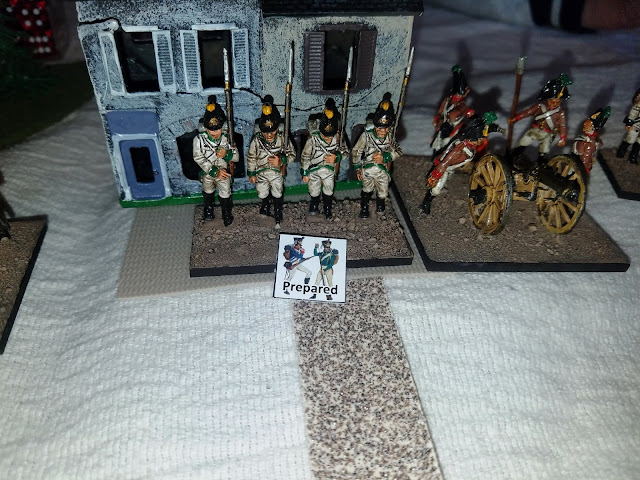Below is the order of battle we used for our game:
Austrian Army (411 pts, breakpoint 11):
Riesch's Corps, Poor, 1D6+4 activations.
8 x Veteran Line Infantry
1 x Veteran Grenz
1 x Hussars
1 x Uhlans
1 x Foot Artillery
Werneck's Corps, Poor, 1D6+4 activations.
8 x Veteran Line Infantry
1 x Veteran Grenz
1 x Hussars
1 x Uhlans
1 x Foot Artillery
Kienmayer's Reserve Corps, Hero, Inspiring, 1D6+7
4 x Hungarian Line (Impetuous)
4 x Grenadiers
1 x Curassiers
1 x Dragoons
1 x Foot Battery
1 x Horse Battery
French Army (453 pts, breakpoint 11):
Soult's Corps, Hero, Inspiring, 1D6+6
8 x Ligne/Legere Infantry
2 x Foot Batteries
2 x Lt Cavalry
Lannes' Corps, Inspiring, 1D6+8
5 x Ligne/Legere Infantry
3 x Grenadiers (Oudinot's Division)
1 x Heavy Battery
2 x Lt Cavalry
Ney's Corps, Inspiring, 1D6+9
8 x Ligne/Legere Infantry
2 x Foot Dragoons (Ligne w/o traits)
1 x Foot Battery
1 x Horse Battery
2 x Dragoons
Russian Flying Column (64 pts, breakpoint 2):
Miloradovich, Steadfast, 1D6+4
2 x Jagers
2 x Cossacks
1 x Chevalier Guard (Elite Cavalry)
1 x Dragoons
1 x Horse Battery
We again used a variant from the Honour Blucher forum for generating momentum by grading the corps commanders. The player would roll a die for their commander and add a factor unique for that commander, which would indicate the number of activations the player had for his corps. The factor is ghenerated from a spreadsheet which weights the number and quality of the command and the commander's historical ability. We did not use Corps or CinC activations as in the regular Blucher rules, as all activations are individual. The system is simple, fast, & effective.
Pictures of the battle below:
The French are to the left, the Austrians on the right. Soult (near) & Lannes' corps (center) coming out of the woods and deploy. Ney's corps is top/center. The Austrians have approached, with all 3 Austrian corps leaving reserves behind (cards). Kienmayer's reserve corps is in the center.
Just prior to Kienmayer & Lannes closing into action.
Kienmayer has inflicted heavy losses on Lannes (left center). The Russian flying column has appeared as reinforcements (far right).
The Russians deploy.
The end of the battle.
We played about 12 turns, with the Austrians holding an advantage in inflicting casualties & forcing retirements. Both sides had numerous brigades retire due to casualties, but neither army was near the breakpoint.
Most of my friends were new to Blucher, but learned the game very quickly. One set of situations that arose during the game causing discomfort for some was that in Blucher when infantry is required to retreat due to a combat, it does so unless it is fighting any cavalry, in which case the cavalry retreats instead of the infantry. Sam Mustafa has argued in the Honour Forum that he believes infantry in real life would either stand or break to cavalry, and not retreat.
Some details about our game:
Figures are 28mm, mostly Victrix & Perry plastic, & Perry, Brigade Games, & Castingroom miniatures metals.
Bases are 60mm wide (DBN, HFG compatible).
Blucher cards - homemade.
Table dimensions: 6' x 5.'
Fatigue/Ammo recording: used small (10mm) dice to mark fatigue & ammo level next to stands.












